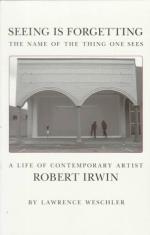
|
| Name: _________________________ | Period: ___________________ |
This test consists of 15 multiple choice questions and 5 short answer questions.
Multiple Choice Questions
1. How do young artists view Irwin?
(a) They view him as just another contemporary artist.
(b) They view him as a celebrity.
(c) They see him as an artist to mimic.
(d) They look up to him as a theorist and ideological mentor.
2. Irwin has always asked legitimate questions about what?
(a) Himself.
(b) His art.
(c) The world.
(d) The world and art.
3. During the mid and late sixties, Irwin supplements his meager art income with earnings from his stints as a teacher. However, his main source of income during this period is from what?
(a) His parents.
(b) Rebuilding cars.
(c) Dancing.
(d) Playing the horses.
4. Robert's installations were made based on what?
(a) Funding.
(b) Supplies.
(c) Time.
(d) Locale.
5. What is the flaw with the discs?
(a) The viewers are still required to "look at something."
(b) They take up space.
(c) They are too heavy.
(d) They are not perfect.
6. Does Robert struggle with the concepts?
(a) Yes, but he makes progress.
(b) Yes, and he makes very little progress.
(c) Yes, and he has made no progress.
(d) No.
7. Irwin experiments with acrylic columns placed in the room and matching the walls, causing the illusion that they dissolve into the room. Unfortunately, some viewers conclude what?
(a) Irwin is leaving the art world.
(b) Irwin has transitioned over to sculpture.
(c) Irwin has lost his mind.
(d) Irwin is now an interior designer.
8. Describe his writing.
(a) Dry and boring.
(b) Convoluted, mired in itself and rambling.
(c) Flowery and detailed.
(d) Simple and straightforward.
9. At a 1971 display at UCLA's museum, Irwin redoes a utility stairway with what?
(a) A new railing.
(b) New lighting and other minor adjustments.
(c) A new color palette.
(d) New stairs.
10. Irwin sets about reading everything he can about this philosophy, sometimes spending how much time reading, analyzing, and trying to understand every turn of phrase?
(a) An hour.
(b) All day.
(c) Ten minutes.
(d) A week.
11. To Irwin it is a way of portraying perception as what?
(a) Only from his view.
(b) What one must believe.
(c) The essential subject of art.
(d) Secondary to light and shadow.
12. Irwin is drawn to what?
(a) Los Angeles.
(b) New York.
(c) The desert.
(d) The ocean.
13. Researchers in science like Wortz and researchers in art like Irwin have more in common with each other than they do with the technicians in their own fields. Irwin dubs this relationship __________________. T
(a) "The dialogue of the insane."
(b) "The dialogue of immanence."
(c) "The dialogue of collaboration."
(d) "The dialogue of the intelligent."
14. ___________ years after the Whitney opening, Irwin is busy with multiple proposals for projects for cities and universities.
(a) Seven.
(b) Four.
(c) Three.
(d) Ten.
15. Irwin feels that the most important result of his association with Dr. Wortz is what?
(a) The discoveries they made as a team.
(b) The art they made together.
(c) Each man radically changed the life of the other forever.
(d) The lessons they learned.
Short Answer Questions
1. When Irwin is told that Sartre dropped everything to learn about this philosophy, what did Irwin do?
2. Not knowing what direction his life is taking, Irwin does what?
3. Now, with no such material objects in his life, Irwin has to do what?
4. Irwin invites a young artist, James Turrell, to join him in the project. Irwin and Turrell wind up partnered on a project with Dr. Ed Wortz of Garrett Aerospace Corporation. Irwin admires Wortz's ability to do what?
5. From where is this fabric hung?
|
This section contains 620 words (approx. 3 pages at 300 words per page) |

|




